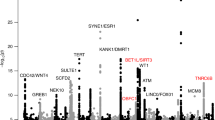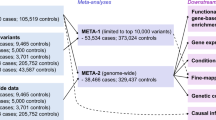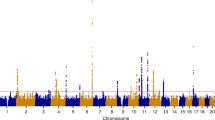Abstract
Uterine leiomyomata (UL) are the most common female pelvic tumors and the primary indication for hysterectomy in the United States. We assessed genetic liability for UL by a known embryonic proliferation modulator, HMGA2, in 248 families ascertained through medical record-confirmed affected sister-pairs. Using a (TC) n repeat in the 5′ UTR and 17 SNPs spanning HMGA2, permutation-based association tests identified a significant increase in transmission of a single TC repeat allele (TC227) with UL (allele-specific P = 0.00005, multiple testing corrected min-P = 0.0049). The hypothesis that TC227 is a pathogenic variant is supported by a trend towards higher HMGA2 expression in TC227 allele-positive compared with non-TC227 UL tissue as well as by absence of culpable exonic sequence variants. HMGA2 has also been suggested recently by three genome-wide SNP studies to influence human height variation, and our examination of the affected sister-pair families revealed a significant association of TC227 with decreased height (allele-specific P = 0.00033, multiple testing corrected min-P = 0.016). Diminished stature and elevated risk of UL development have both been correlated with an earlier age of menarche, which may be the biological mechanism for TC227 effects as a tendency of women with TC227 to have an earlier onset of menarche was identified in our study population. These results indicate HMGA2 has a role in two growth-related phenotypes, UL predisposition and height, of which the former may affect future medical management decisions for many women.



Similar content being viewed by others
References
Abecasis GR, Cookson WO (2000) GOLD—graphical overview of linkage disequilibrium. Bioinformatics 16:182–183
Borrmann L, Seebeck B, Rogalla P, Bullerdiek J (2003) Human HMGA2 promoter is coregulated by a polymorphic dinucleotide (TC)-repeat. Oncogene 22:756–760
Buttram VC Jr, Reiter RC (1981) Uterine leiomyomata: etiology, symptomatology, and management. Fertil Steril 36:433–445
Chiba-Falek O, Nussbaum RL (2001) Effect of allelic variation at the NACP-Rep1 repeat upstream of the alpha-synuclein gene (SNCA) on transcription in a cell culture luciferase reporter system. Hum Mol Genet 10:3101–3109
Cramer SF, Patel A (1990) The frequency of uterine leiomyomas. Am J Clin Pathol 94:435–438
Flynn M, Jamison M, Datta S, Myers E (2006) Health care resource use for uterine fibroid tumors in the United States. Am J Obstet Gynecol 195:955–964
Gattas GJ, Quade BJ, Nowak RA, Morton CC (1999) HMGIC expression in human adult and fetal tissues and in uterine leiomyomata. Genes Chromosomes Cancer 25:316–322
Gross KL, Neskey DM, Manchanda N, Weremowicz S, Kleinman MS, Nowak RA, Ligon AH, Rogalla P, Drechsler K, Bullerdiek J, Morton CC (2003) HMGA2 expression in uterine leiomyomata and myometrium: quantitative analysis and tissue culture studies. Genes Chromosomes Cancer 38:68–79
Gudbjartsson DF, Walters GB, Thorleifsson G, Stefansson H, Halldorsson BV, Zusmanovich P, Sulem P, Thorlacius S, Gylfason A, Steinberg S, Helgadottir A, Ingason A, Steinthorsdottir V, Olafsdottir EJ, Olafsdottir GH, Jonsson T, Borch-Johnsen K, Hansen T, Andersen G, Jorgensen T, Pedersen O, Aben KK, Witjes JA, Swinkels DW, den Heijer M, Franke B, Verbeek AL, Becker DM, Yanek LR, Becker LC, Tryggvadottir L, Rafnar T, Gulcher J, Kiemeney LA, Kong A, Thorsteinsdottir U, Stefansson K (2008) Many sequence variants affecting diversity of adult human height. Nat Genet 40:609–615
Hartmann KE, Birnbaum H, Ben-Hamadi R, Wu EQ, Farrell MH, Spalding J, Stang P (2006) Annual costs associated with diagnosis of uterine leiomyomata. Obstet Gynecol 108:930–937
Hirning-Folz U, Wilda M, Rippe V, Bullerdiek J, Hameister H (1998) The expression pattern of the Hmgic gene during development. Genes Chromosomes Cancer 23:350–357
Huyck KL, Panhuysen CI, Cuenco KT, Zhang J, Goldhammer H, Jones ES, Somasundaram P, Lynch AM, Harlow BL, Lee H, Stewart EA, Morton CC (2008) The impact of race as a risk factor for symptom severity and age at diagnosis of uterine leiomyomata among affected sisters. Am J Obstet Gynecol 198(168):e161–e169
Ishwad CS, Shriver MD, Lassige DM, Ferrell RE (1997) The high mobility group I-C gene (HMGI-C): polymorphism and genetic localization. Hum Genet 99:103–105
Klotzbucher M, Wasserfall A, Fuhrmann U (1999) Misexpression of wild-type and truncated isoforms of the high-mobility group I proteins HMGI-C and HMGI(Y) in uterine leiomyomas. Am J Pathol 155:1535–1542
Kurbanova M, Koroleva AG, Sergeev AS (1989) Genetic-epidemiologic analysis of uterine myoma: assessment of repeated risk. Genetika 25:1896–1898
Launonen V, Vierimaa O, Kiuru M, Isola J, Roth S, Pukkala E, Sistonen P, Herva R, Aaltonen LA (2001) Inherited susceptibility to uterine leiomyomas and renal cell cancer. Proc Natl Acad Sci USA 98:3387–3392
Lee YS, Dutta A (2007) The tumor suppressor microRNA let-7 represses the HMGA2 oncogene. Genes Dev 21:1025–1030
Lepine LA, Hillis SD, Marchbanks PA, Koonin LM, Morrow B, Kieke BA, Wilcox LS (1997) Hysterectomy surveillance—United States, 1980–1993. MMWR CDC Surveill Summ 46:1–15
Lettre G, Jackson AU, Gieger C, Schumacher FR, Berndt SI, Sanna S, Eyheramendy S, Voight BF, Butler JL, Guiducci C, Illig T, Hackett R, Heid IM, Jacobs KB, Lyssenko V, Uda M, Boehnke M, Chanock SJ, Groop LC, Hu FB, Isomaa B, Kraft P, Peltonen L, Salomaa V, Schlessinger D, Hunter DJ, Hayes RB, Abecasis GR, Wichmann HE, Mohlke KL, Hirschhorn JN (2008) Identification of ten loci associated with height highlights new biological pathways in human growth. Nat Genet 40:584–591
Luoto R, Kaprio J, Rutanen EM, Taipale P, Perola M, Koskenvuo M (2000) Heritability and risk factors of uterine fibroids—the Finnish Twin Cohort study. Maturitas 37:15–26
Marshall LM, Spiegelman D, Goldman MB, Manson JE, Colditz GA, Barbieri RL, Stampfer MJ, Hunter DJ (1998) A prospective study of reproductive factors and oral contraceptive use in relation to the risk of uterine leiomyomata. Fertil Steril 70:432–439
Moore SD, Herrick SR, Ince TA, Kleinman MS, Cin PD, Morton CC, Quade BJ (2004) Uterine leiomyomata with t(10;17) disrupt the histone acetyltransferase MORF. Cancer Res 64:5570–5577
Okladnova O, Syagailo YV, Tranitz M, Stober G, Riederer P, Mossner R, Lesch KP (1998) A promoter-associated polymorphic repeat modulates PAX–6 expression in human brain. Biochem Biophys Res Commun 248:402–405
Onland-Moret NC, Peeters PH, van Gils CH, Clavel-Chapelon F, Key T, Tjonneland A, Trichopoulou A, Kaaks R, Manjer J, Panico S, Palli D, Tehard B, Stoikidou M, Bueno-De-Mesquita HB, Boeing H, Overvad K, Lenner P, Quiros JR, Chirlaque MD, Miller AB, Khaw KT, Riboli E (2005) Age at menarche in relation to adult height: the EPIC study. Am J Epidemiol 162:623–632
Perola M, Sammalisto S, Hiekkalinna T, Martin NG, Visscher PM, Montgomery GW, Benyamin B, Harris JR, Boomsma D, Willemsen G, Hottenga JJ, Christensen K, Kyvik KO, Sorensen TI, Pedersen NL, Magnusson PK, Spector TD, Widen E, Silventoinen K, Kaprio J, Palotie A, Peltonen L (2007) Combined genome scans for body stature in 6, 602 European twins: evidence for common Caucasian loci. PLoS Genet 3:e97
Rabinowitz D (1997) A transmission disequilibrium test for quantitative trait loci. Hum Hered 47:342–350
Rabinowitz D, Laird N (2000) A unified approach to adjusting association tests for population admixture with arbitrary pedigree structure and arbitrary missing marker information. Hum Hered 50:211–223
Reed WB, Walker R, Horowitz R (1973) Cutaneous leiomyomata with uterine leiomyomata. Acta Derm Venereol 53:409–416
Rein MS, Friedman AJ, Barbieri RL, Pavelka K, Fletcher JA, Morton CC (1991) Cytogenetic abnormalities in uterine leiomyomata. Obstet Gynecol 77:923–926
Sanna S, Jackson AU, Nagaraja R, Willer CJ, Chen WM, Bonnycastle LL, Shen H, Timpson N, Lettre G, Usala G, Chines PS, Stringham HM, Scott LJ, Dei M, Lai S, Albai G, Crisponi L, Naitza S, Doheny KF, Pugh EW, Ben-Shlomo Y, Ebrahim S, Lawlor DA, Bergman RN, Watanabe RM, Uda M, Tuomilehto J, Coresh J, Hirschhorn JN, Shuldiner AR, Schlessinger D, Collins FS, Davey Smith G, Boerwinkle E, Cao A, Boehnke M, Abecasis GR, Mohlke KL (2008) Common variants in the GDF5-UQCC region are associated with variation in human height. Nat Genet 40:198–203
Searle S, Blackwell JM (1999) Evidence for a functional repeat polymorphism in the promoter of the human NRAMP1 gene that correlates with autoimmune versus infectious disease susceptibility. J Med Genet 36:295–299
Shimajiri S, Arima N, Tanimoto A, Murata Y, Hamada T, Wang KY, Sasaguri Y (1999) Shortened microsatellite d(CA)21 sequence down-regulates promoter activity of matrix metalloproteinase 9 gene. FEBS Lett 455:70–74
Snieder H, MacGregor AJ, Spector TD (1998) Genes control the cessation of a woman’s reproductive life: a twin study of hysterectomy and age at menopause. J Clin Endocrinol Metab 83:1875–1880
Stewart EA, Morton CC (2006) The genetics of uterine leiomyomata: what clinicians need to know. Obstet Gynecol 107:917–921
Treloar SA, Martin NG, Dennerstein L, Raphael B, Heath AC (1992) Pathways to hysterectomy: insights from longitudinal twin research. Am J Obstet Gynecol 167:82–88
Weedon MN, Lettre G, Freathy RM, Lindgren CM, Voight BF, Perry JR, Elliott KS, Hackett R, Guiducci C, Shields B, Zeggini E, Lango H, Lyssenko V, Timpson NJ, Burtt NP, Rayner NW, Saxena R, Ardlie K, Tobias JH, Ness AR, Ring SM, Palmer CN, Morris AD, Peltonen L, Salomaa V, Davey Smith G, Groop LC, Hattersley AT, McCarthy MI, Hirschhorn JN, Frayling TM (2007) A common variant of HMGA2 is associated with adult and childhood height in the general population. Nat Genet 39:1245–1250
Yamada N, Yamaya M, Okinaga S, Nakayama K, Sekizawa K, Shibahara S, Sasaki H (2000) Microsatellite polymorphism in the heme oxygenase-1 gene promoter is associated with susceptibility to emphysema. Am J Hum Genet 66:187–195
Zhou X, Benson KF, Ashar HR, Chada K (1995) Mutation responsible for the mouse pygmy phenotype in the developmentally regulated factor HMGI-C. Nature 376:771–774
Acknowledgments
The authors thank Weining Lu for real-time PCR instruction, Rita Cantor for helpful comments on the manuscript, Efthymia Melista and Alison Brown for assistance with genotyping, and all the women and their families who participated in this study. This work was supported by NIH grants RO1HD046226 and RO1CA78895 (to CCM). JCH was supported by T32GM007748 and KLH by a Howard Hughes Medical Institute Predoctoral Fellowship in Biological Sciences.
Author information
Authors and Affiliations
Corresponding author
Additional information
J. C. Hodge and K. T.Cuenco are to be regarded as co-First Authors.
Rights and permissions
About this article
Cite this article
Hodge, J.C., T.Cuenco, K., Huyck, K.L. et al. Uterine leiomyomata and decreased height: a common HMGA2 predisposition allele. Hum Genet 125, 257–263 (2009). https://doi.org/10.1007/s00439-008-0621-6
Received:
Accepted:
Published:
Issue Date:
DOI: https://doi.org/10.1007/s00439-008-0621-6




